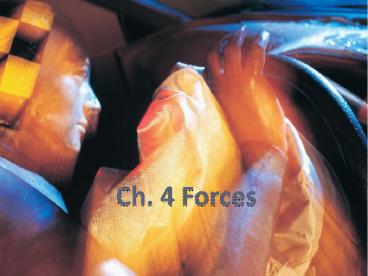Ch.%204%20Forces - PowerPoint PPT Presentation
Title:
Ch.%204%20Forces
Description:
Title: Ch. 4 Forces Author: alice hall Last modified by: Pmunshower Created Date: 10/13/2006 1:18:14 PM Document presentation format: On-screen Show (4:3) – PowerPoint PPT presentation
Number of Views:55
Avg rating:3.0/5.0
Title: Ch.%204%20Forces
1
Ch. 4 Forces
2
- Describe an objects acceleration in terms of its
mass and the net force - acting on it.
- Predict the direction and magnitude of the
acceleration caused by a known - net force.
- 3. Identify action-reaction pairs.
3
(No Transcript)
4
Newtons 2nd Law
- Force is proportional to mass and acceleration.
- The acceleration of an object is directly
proportional to the net external force acting on
the object and inversely proportional to the
objects mass. - The direction of the acceleration is in the same
direction as the applied force
5
- Newtons 2nd Law of Motion (N2), the Law of
Acceleration - The acceleration of an object is directly
proportional to the net force acting on the
object - a SF
- m
6
- .
- Comment The essence of Newtons 2nd Law is that
an object WILL ACCELERATE if and only if the
EXTERNAL FORCES acting on it are NOT BALANCED. A
Free Body Diagram is used to depict the external
forces and Newtons 2nd Law ties the dynamics to
the kinematics. Each external force includes a
type, a direction, and a source.
7
Newtons 2nd Law
- F ma
- Force (F) has units of Newtons (N)
- Mass (m) has units of kilograms (kg)
- Acceleration (a) has units of meters per second
squared (m/s2)
8
In other words..using the same amount of force.
Small acceleration
a
Large Mass
Large acceleration
a
Small Mass
9
- Roberto and Laura are studying across from each
other at a wide table. Laura slides a 2.2 kg
book towards Roberto. If the net external force
acting on the book is 2.6 N to the right, what is
the books acceleration?
10
(No Transcript)
11
Newtons 3rd Law
- For every action there is an equal and opposite
reaction - Force always exist in pairs, even field forces
- Pairs are known as action-reaction pairs
12
- Newtons 3rd Law of Motion (N3), the Law of
Interaction - When one object exerts a force on a second object
the second object exerts the same magnitude force
in the opposite direction on the first object
SIMULTANEOUSLY. - Comment The essence of Newtons 3rd Law is
that all forces are actually pairs in which the
objects force each other simultaneously and
oppositely REGARDLESS of the MOTION of EITHER.
However, since we NEVER SEE FORCES we cannot see
this relationship.
13
Action and Reaction pairs
- Action-reaction pairs do not imply that the net
force on either object is zero. - The action-reaction forces are equal and opposite
but either object may still have a net force on
it.
14
Earth / Apple (cont.)
The products are the same, since the forces are
the same.
a m
m
a
Apples little mass
Earths big mass
Earths little acceleration
Apples big acceleration
15
- Identify the action-reaction pair in the
following situations. - A person takes a step
- A snowball hits someone in the back
16
- Identify the action-reaction pair in the
following situations. - A baseball player catches a ball
- A gust of wind strikes a window
17
- The forces acting on a sailboat are 390 N north
and 180 N east. If the boat has a mass of 270
kg, what are the magnitude and direction of its
acceleration?
18
- If a locomotive can exert a constant pull of
7.5x105 N, how long would it take to increase the
speed of the train from rest to 85 km/h?
(disregard friction)































